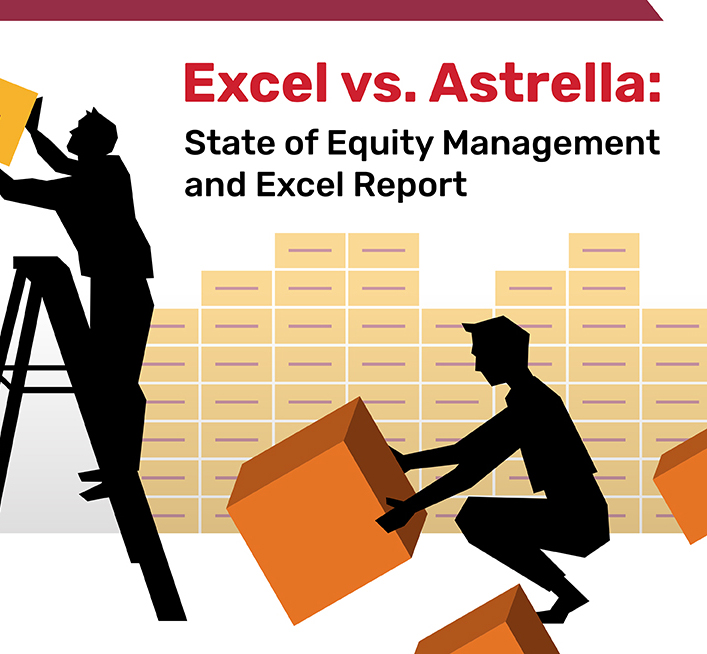When starting a business, it’s important to understand the different ways to structure your company’s ownership and financing. One of the key tools used to do this is a capitalization table (cap table). A cap table outlines who owns what percentage of your company, as well as the terms and conditions of their ownership.
In this blog post, we’ll provide an overview of some common cap table scenarios to help you better understand how to structure your company’s ownership and financing. We’ll discuss the different types of equity that can be issued to founders, investors, and employees and the terms of these equity investments. We’ll also cover the different types of secondary transactions that can occur after a company has gone through its initial round of funding.
Founders’ Equity
When starting a company, the founders typically take on the most risk and put in the most work. As such, they are usually rewarded with a significant portion of the company’s equity. Founders’ equity generally consists of common stock, which represents ownership in the company. Before any outside investment, the founders typically own all of the company’s stock. However, the founders’ ownership percentage will usually decrease as the company grows and takes on outside investment. This is because new investors will typically purchase company shares in exchange for cash or other assets.
The amount of equity that founders receive can vary depending on several factors, including the stage of the company, the amount of investment being raised, and the negotiating power of the founders. In early-stage companies, founders may own most of the company’s stock. However, as the company grows and takes on more investment, the founders’ ownership percentage will typically decrease. This is because new investors will typically purchase shares of the company in exchange for cash or other assets.
Founders should be aware of the potential dilution of their ownership as the company grows. However, they should also recognize that outside investment can be essential for the company’s growth. By carefully negotiating the terms of their equity investments, founders can help to ensure that they are fairly compensated for their contributions to the company.
Series A Financing
Series A financing is typically the first round of institutional funding that a company raises. In this round, preferred stock is issued to investors in exchange for their investment. The preferred stock typically has a liquidation preference, which gives investors priority over common stockholders in the event of a sale or liquidation of the company. This means that if the company is sold or goes bankrupt, the preferred stockholders will be paid back before the common stockholders. The preferred stock may also have a dividend, which is a fixed payment made to investors regularly.
In addition to preferred stock, companies may issue warrants to investors in a Series A financing round. Warrants give investors the right to purchase common stock at a set price in the future. This can be valuable if the company’s stock price increases after issuing warrants.
The amount of money raised in a Series A financing round can vary significantly from company to company. Some companies may only raise a few million dollars, while others may raise tens of millions. The amount of money raised will depend on the company’s stage of development, its business model, and the current market conditions.
Series A financing is an important milestone for a company. It can provide the company with the capital it needs to grow its business and achieve profitability. However, it is essential to note that Series A financing does not guarantee success. Many companies that raise funding for Series A ultimately fail. Therefore, it is necessary for companies to carefully consider their options before raising Series A financing.
Employee Stock Options
Employee stock options (ESOs) are a type of equity compensation that gives employees the right to purchase a certain number of shares of company stock at a set price in the future. ESOs are often used to attract and retain top talent, as they can provide employees with a significant financial incentive to stay with the company.
The terms of ESOs can vary significantly from company to company. Some key terms that employees should be aware of include the number of options granted, the exercise price, the vesting schedule, the strike price, the expiration date, and any repurchase rights the company may have if an employee leaves the company before the options are vested.
The number of options granted to an employee is typically based on their position and level of responsibility within the company. The exercise price is the price the employee must pay to purchase the shares of stock. The vesting schedule determines when the employee becomes eligible to exercise their options. The strike price is the price at which the employee can purchase the shares of stock. The expiration date is when the employee must exercise their options. Finally, repurchase rights allow the company to buy back the options from the employee if they leave the company before the options are vested.
ESOs can be a valuable form of compensation for employees, but it is essential to understand the terms of the ESOs before accepting them. Employees should also be aware of the potential tax implications of ESOs.
Preferred Stock Investment
Investors seeking an optimal balance between debt and equity financing can find preferred stock as an enticing option, offering specific advantages over common stock. These advantages manifest in three key areas: liquidation preferences, dividend rights, and conversion rights. In the unfortunate event of a company’s sale or liquidation, preferred shareholders take precedence over common shareholders, ensuring their investment is recovered before any distribution. Additionally, preferred shareholders enjoy the privilege of receiving regular payments from the company, known as dividends. Finally, some preferred stocks have conversion rights, allowing holders to convert their preferred shares into common stock at a predetermined price.
The terms governing preferred stock investments can vary significantly, and entrepreneurs must familiarize themselves with the critical aspects. The liquidation preference stipulates the amount of capital preferred shareholders are entitled to receive in a sale or liquidation. The dividend rate determines the frequency and quantum of dividend payments. The conversion price establishes the rate at which preferred shares can be converted into common stock. Lastly, the vesting schedule outlines the timeline for preferred shareholders to exercise their conversion rights.
Entrepreneurs should exercise caution and meticulously scrutinize a preferred stock investment proposal’s terms before committing. It is imperative to grasp the inherent benefits and drawbacks of preferred stock and ensure that the proposed terms strike a fair balance between the interests of the company and the investors. While preferred stock can serve as a valuable funding source for companies, it must be employed judiciously to optimize its advantages without compromising the company’s financial health.
When considering preferred stock as a financing option, entrepreneurs should engage in thorough due diligence and seek professional advice to navigate the complexities of this investment instrument. By carefully evaluating the terms and conditions, entrepreneurs can leverage the benefits of preferred stock while mitigating potential risks, ultimately securing a sustainable path for their business growth.
Venture Debt
Venture debt is a type of financing designed explicitly for startups and early-stage companies. It is typically provided by specialized lenders who understand these types of businesses’ unique challenges and risks. Venture debt can be used for various purposes, including working capital, inventory, and other short-term needs.
One of the critical advantages of venture debt is that it is often more flexible than traditional bank loans. Lenders are typically more willing to work with startups and early-stage companies that may not have a long track record or significant assets. Venture debt can also be tailored to the company’s specific needs, such as providing a more extended repayment period or allowing for interest-only payments.
However, venture debt also typically has a higher interest rate than traditional bank loans. This is because lenders are taking on more risk by lending to startups and early-stage companies. The interest rate on venture debt can vary depending on several factors, including the company’s stage of development, its financial condition, and the current market conditions.
Venture debt can be a valuable source of financing for startups and early-stage companies. It can provide the necessary capital to help these companies grow and succeed. However, it is essential to consider the terms of a venture debt loan before accepting it. Ensure you understand the interest rate, repayment period, and any other fees or conditions associated with the loan.
Secondary Transactions
After a company has gone through its initial round of financing, several different types of secondary transactions can occur. These transactions can involve the sale of stock by existing investors to new investors, the sale of stock by the company to new investors, the sale of stock by employees to new investors, the sale of stock by the company to existing investors, and the sale of stock by employees to existing investors.
Secondary transactions can be used for various purposes, including raising additional capital, providing liquidity to investors, and rewarding employees for their contributions to the company. The type of secondary transaction used will depend on the company’s and its investors’ specific needs.
One common type of secondary transaction is the sale of stock by existing investors to new investors. This type of transaction can be used to raise additional capital for the company or provide liquidity to existing investors who want to cash out their investments. In a typical secondary transaction, the existing investors will sell their stock to a new investor at a price that is agreed upon by both parties.
Another type of secondary transaction is the sale of stock by the company to new investors. This type of transaction is often used to raise additional capital for the company, or it can be used to reward employees for their contributions to the company. In a typical secondary transaction, the company will issue new shares of stock and sell them to a new investor at a price that is agreed upon by both parties.
Secondary transactions can be complex and time-consuming, but they can also be a valuable tool for companies and investors. By carefully planning and executing a secondary transaction, companies can raise capital, provide liquidity to investors, and reward employees for their contributions.
Exit Planning
In exit planning, several cap table scenarios are typically considered:
- Pre-exit Ownership Structure Analysis: This involves understanding the current ownership structure, including founders, investors, employees with stock options, and other stakeholders. Knowing how each party’s shares will be valued and liquidated in an exit scenario is essential.
- Dilution Impact Analysis: This scenario explores how future funding rounds and issuing new shares or options could dilute existing ownership percentages. This is crucial for understanding how much each shareholder would receive in an exit event.
- Liquidation Preferences and Waterfall Analysis: In this scenario, the focus is on the preferences and rights of different classes of shareholders (like preferred vs. common stock). Liquidation preferences determine the payout order and amount in an exit. A waterfall analysis shows how proceeds from an exit are distributed among shareholders.
- Exit Valuation Scenarios: This involves estimating the company’s valuation at the exit and analyzing how different exit valuations (like high, medium, or low) affect the payouts to different stakeholders. It helps in understanding the potential financial outcomes for shareholders.
- Employee Option Pool Analysis: The focus is on how existing and future employee stock option pools will be treated in an exit scenario. This includes understanding the impact of options on overall dilution and the potential payouts to employees.
- Tax Implications: Different exit scenarios can have varied tax implications for shareholders. Analyzing these implications is crucial to understanding the net proceeds each shareholder would receive.
- Scenario Modeling for Different Exit Strategies: This involves creating models for different exit strategies (like an outright sale, merger, or IPO) and understanding how each strategy impacts shareholder payouts.
- Investor Rights and Agreements: Review existing investor agreements to understand rights, such as drag-along or tag-along rights, which can influence the exit process and outcomes.
These scenarios help company leadership and shareholders to plan and prepare for an exit, understand the financial implications, and make informed decisions to maximize value and ensure fair treatment of all stakeholders.
Conclusion
Depending on different business scenarios, you’re going to see different approaches to cap table management and scenario modeling. But, if you are prepared for that, then your cap table is your first and more important line of preparation.

Tom Kirby
Tom Kirby serves as the Head of Global Sales at Astrella. With more than 20 years of experience in sales and business development, he is dedicated to fostering strong client relationships and assisting both private and public companies in understanding and effectively communicating their value.
- Tom Kirby#molongui-disabled-link
- Tom Kirby#molongui-disabled-link
- Tom Kirby#molongui-disabled-link
- Tom Kirby#molongui-disabled-link
































































































































